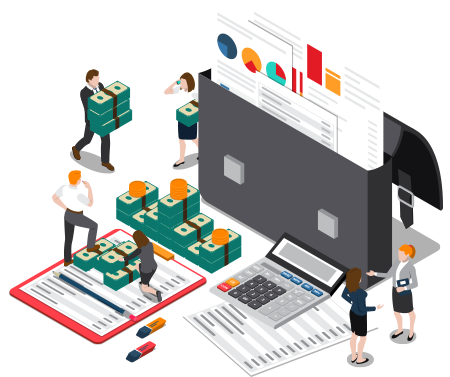





| COURSE CODE | COM 1327 |
| MEDIUM | ENGLISH |
| QUALIFICATION | DEGREE & ABOVE |
| DURATION | 6 MONTHS |
| CLASS TIMINGS | 10:00 AM TO 04:00 PM |
| MARK ALLOTMENT | THEORY: 100 MARKS |
| PRACTICAL | 100 MARKS |
| INTERNAL | 100 MARKS |
| PASSING MARKS | 40/100 |





[Journal – Ledger System]
Basic Principles of Accounting – Journalizing , Ledger Posting, Balancing, Preparation of Trial Balance and Finalization of Accounts ( Preparation of Trading Account, Profit and Loss Account and Balance Sheet.)
S1 Short title- extent and commencement—S2 Definitions : Aggregate turn over –business–business vertical-input tax –- out put tax – inward supply –outward supply– composite supply–mixed supply –-consideration– input service distributor – input service– nonresident taxable person – reverse charge– tax return preparer–credit note, debit note, exempt supply–export of goods,–export of service, IGST, import of goods– import of service– input service – input service distributor– input tax-input tax credit- inward supply– place of supply– outward supply–continuous supply of goods-service-reverse charge-zero rated supply,–works contract.
S3 Officers under this Act, –S4.appointment,–S5 powers etc.—
S7.Levy & Collection: Supply –S8.tax liability on composite and mixed supplies S9.Charging Section-Reverse charge-levy and collection of tax-S10.Tax liability on composite and mixed supplies –Rules-GSTCMP 01 and all other forms-effective date of composition levy-conditions-validity-rate of composition.S11.Power to grant exemptions.
Time and Value of Supply: S12-13-Time of Supply of goods/services –S14. Change in rate of tax in respect of supply of goods or services. S15. Value of taxable supply-
Input Tax Credit: S16-Eligibility for input Tax credit-conditions for taking input tax credit S17 apportionment of credit and blocked credits S18. Availability of credit in special circumstances S19.taking input tax credit in respect of inputs and capital goods sent for job works. S20 Distribution of credit by input service distributor-
Registration: S22-Persons liable for registration S23. Persons not liable for registration-S24. Compulsory registration in certain cases. S25. Procedure for registration S26.Deemed registration-S27.Special provisions relating to casual taxable persons and non resident taxable persons-S28. Amendment of registration- S29. Cancellation of registration-
Tax Invoice, Debit and Credit Notes : S31-Tax invoice-S32 –Prohibition of unauthorized collection of tax- S33. Amount of tax to be indicated in tax invoice and other documents– S34.Debit and Credit Notes. –.
S35,Accounts and other records–36 Period of retention of accounts.
Returns; S37- Furnishing details of outward supplies.–S38.Furnishing details of inward supplies –S39.Submission of returns (R59) –S40.First Return– S41 Claim of input tax credit and provisional acceptance thereof–.S42.Matching, reversal and reclaim of input tax credit –S43. Matching ,reversal and reclaim of output tax liability–.S44 Annual return– S45. final returns –S46. Notice to return defaulters–S47 Levy of late fee– S48 GST Practitioners
Payment of Tax: S49 Payment of tax, interest, penalty and other amounts–S50 interest on delayed payment of tax–S51- TDS– S 52Collection of tax at source–S53. Transfer of input tax credit –
S54 Refund
Assessment: S59-Self assessment– S60 Provisional Assessment– S61. Scrutiny of returns –S62. Assessment of non filers of return –S63 Assessment of unregistered persons
Audit: S65-Audit by tax authorities
Inspection, Search, Seizure and Arrest S67Inspection,Search,seizure and arrest– S68 inspection of goods in movement.– S69. Power to arrest.– S70 Power to summon persons to give evidence and produce document. S71. Access to business premises
Demand and Recovery.S73 Determination of tax not paid or short paid — S74Determination of tax not paid or short paid by fraud–S76 Tax collected but not deposited to government –S79Recovery of tax and procedure —
S85 to S94 Liability to pay tax in certain cases –S95 to 106–Advance ruling –107-121-appeals and revision—
S122–138 Offences and penalties
Integrated Goods and Services Tax Act – 2017:
S4.Authorisation of officers of State Tax or union Territory tax as proper officers in certain circumstances—
S 7-interstate supply— S8-intra state supply— S9 supplies in territorial waters—S-10-Place of supply of goods other than supply of goods imported in to or exported from India. S11- Place of supply of goods imported in to or exported from India S.12: Place of supply of services where location of supplier and recipient is in India. S.13—Place of supply of services where location of supplier or location of recipient is outside India.
S14.Special provision for payment of tax by a supplier of online information and database access or retrieval services
S15.Refund of integrated tax paid on supply of goods to tourist leaving India.S16. Zero rated supply –S17:Apportionment of tax and settlement of funds
S18:Transfer of input tax credit S19:Tax wrongly collected and paid to central government or state government.
Meaning of Accounting –Definition of Accounting- Features of accounting-objectives of accounting-Book keeping and accounting- Advantages and limitations of accounting.
1 Introduction to Accounting Definition – Types of Accounts – Classification of Accounts Rules of Accounting – Journal – Ledger – Journalizing – Ledger posting – Balancing – Trial balance Final Accounts, Final Accounts with Adjustments . Introduction to computerized accounting: computerized accounting Vs. Manual accounting-Tally 9-Features of Tally-Screen components-Creation of company – selecting a company – altering/ modifying company creation details –deleting a company – F11 Features- F 12 configuration
Accounts and Vouchers –Account groups: – Pre-defined groups creating single & multiple groups – creation of primary account groups – creating ledger accounts in single &multiple – displaying, altering and deleting account groups and ledgers – Accounting vouchers – entering transactions in accounting vouchers – bill wise details – altering and deleting a voucher entry – creating new voucher types – modifying an existing voucher – bank reconciliation statement –balance sheet – profit and loss account – trial balance – day books – account books – statement of accounts – list of accounts
Voucher Type:- Type of vouchers –Creating/Customizing new voucher type-Displaying voucher type-Alerting voucher type-Deletion of voucher type
Accounts with inventory: – Enabling F11 and F12 – stock category – stock group – single / multiple creation of stock category and stock group – creation of units of measurement – creating single / multiple stock items – creating godowns – displaying, altering and deleting stock groups, units, items and godowns – cost categories – cost centers – creating cost categories and cost centers – displaying, altering and deleting cost categories and cost centers – purchase / sales orders – inventory vouchers – using inventory vouchers – using accounting vouchers with inventory details (invoice mode ) – inventory reports – stock summary – inventory books – statement of inventory.
Introduction of GST- CGST, SGST, IGST, Activating GST, GST ledgers, party ledger creation with GST, Purchase (Inward Supply) & sales (Outward Supply) under GST
Manufacturing, budget and currency: – Manufacturing- Bill of Materials-Manufacturing Journal-Cost estimates-Budget-type of budget-Budget creation-Alteration and Deletion of budget- Currency creation-Adjustment of forex gain/loss- Creation of journal voucher class for forex gain/loss.
Final Accounts Reports :- Profit and loss account-Balance sheet- Trial balance- Daybook-Account book- Statement of accounts- Tax report.
E-Return Filing-GST & Income Tax
Leave a Reply